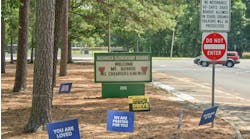Violence has shaken many schools across the country. More than two dozen school shootings have occurred since the school year began; yet there is hope. Communities are banding together to protect their children. Schools are working on many fronts to curb aggression and keep students out of harm's way.
There is no magic answer to keeping violence out of schools. It requires a multifaceted effort from administrators, staff, parents and students. Available strategies include peer mediation and conflict resolution training, video analytics in school “hot spots,” and teaching students how to use the Internet safely.
Resolving conflicts
Numerous methods are available for defusing conflicts before they erupt. Teaching conflict-resolution techniques to students and teachers can give them the skills to resolve disagreements, deal with bullies, and cope with other issues that can spin out of control if not addressed quickly. Schools should teach students ways to “cool down” when angered. Many schools also are training staff members and students as conflict mediators. If a quarrel is escalating, those involved could be brought before a peer counselor as an alternative form of discipline.
The National Crime Prevention Counsel also has developed programs that help students become part of the solution to school violence. Likewise, Project Citizen's “We the People” program teaches students constitutional responsibility, engaging them in shaping long-term fixes within their own school. The program helps young people learn how to influence public policy. In the process, they develop support for democratic values and principles, tolerance and feelings of political efficacy. Ultimately, the younger we can reach children and give them tools for resolving conflicts, the greater success we will have in preventing violence.
Safe Internet skills
One critical area that needs attention is students' Internet use. Countless young people share photos and other personal information on social networking sites such as MySpace. Sites such as these say they restrict children under 18 from posting, but there's little monitoring to enforce this rule. Many kids don't think twice about putting addresses, ages, schools they attend and photos on their Web pages. They may not realize that anyone with Internet access, including sexual predators, can use that information to track them down. Even seemingly innocuous information such as the type of music and movies a child likes may give predators enough information to wile their way into a child's life. An online predator can pretend to be another kid, sharing the same likes and dislikes. He or she can establish a rapport with a child and soon may suggest a face-to-face meeting.
This problem has become so pervasive that some school officials have taken disciplinary action against underage students who have created pages on MySpace or other social networking sites.
There is another strong incentive to refrain from using these sites. Some colleges search social networking sites to learn whether prospective students are engaging in unsafe online behavior. Parents and teachers need to educate students about the ramifications involved with disclosing information on the Internet and the dangers of meeting new friends online. In many states, the attorney general's office has set up branches to help parents teach children safe Internet skills.
The rules for using the Internet that parents and administrators should impose on children are simple: Don't let them agree to meet someone that they have met online. Don't let them share identfiying information such as a name, address, phone number, age or school name. Prohibit them from using a chat room without supervision. Tell them not to open e-mails from people they don't know and to make sure they tell an adult if something online makes them uncomfortable or suspicious.
Points of vulnerability
About 70 percent of the nation's schools do not use security cameras. These devices can be an integral component for protecting public safety; they can deter illicit activities, create a visual record of incidents and provide an early warning of potential hazards. The state of Washington recently enacted a mandate to place surveillance cameras in all middle schools. Schools considering surveillance systems should first notify parents of their intentions so there is clear communication about the goals. The best approach is to install cameras in areas that are common violence “hot spots” — gyms, cafeterias, hallways and outside school buildings.
Video surveillance technology can alert security personnel of potential safety concerns. Cameras can be programmed to identify suspicious activity and alert authorities immediately. For example, if a system detects someone loitering on school grounds, a signal can be sent to a security officer, who can take control of the surveillance camera to investigate further. The security system also can be used to establish a perimeter around the campus so that authorities are notified instantly if someone enters the premises during the school day. Instead of relying exclusively on security personnel to catch suspicious activity, video systems provide a consistent means to identify and thwart threats.
Many schools have their surveillance systems tied to the local police department so that when suspicious activity occurs, police can monitor what is occurring. In a scenario in which hostages are involved, video could be critical to their safety, as well as to the safety of an entry team planning an approach. The visual footage gives officers a better sense of what is going to happen when they walk into a school under siege. Schools also can share floor plans and architectural features of the school building so that in an emergency, first responders can lay out a tactical plan before they arrive on the scene.
Protection points
Many school administrators have conducted risk assessments to identify potential vulnerabilities, such as access points to a facility. Entranceways should be monitored regularly.
In a high-stress situation, it is easy for communications to break down. Some parents may be frantic, and school officials won't have the resources to call parents individually. Cell phone systems are inadequate in many crises — it took just 15 minutes for cell circuits in Pearl, Miss., to become saturated after a school shooting incident there.
New emergency communication alert systems provide automatic alerts so that everyone — from crisis teams to parents to the media — is kept informed at the touch of a button. School administrators should clearly explain the communication policies to parents ahead of time so they know what to expect.
Technology alone will not stem the tide of violence in schools. The more parents are involved in their children's lives and their school communities, the less likely their children are to behave violently in school. Schools should encourage parents to watch whom their children are spending time with in and out of school. Foster an environment where parents can communicate regularly with one another to share concerns.
Parents and teachers should pay attention to changes in a child's behavior. Warning signs may include a child's developing an obsession with violence or weapons, experiencing a significant drop in grades, or avoiding school and other activities. Unexplained bruises or a need for extra money could indicate that a child is a victim of bullying.
The first response in the wake of school shootings has been to reassure parents, yet it is equally important to be upfront with students so they will feel safe. Teachers should have honest discussions with students. Address the questions they will be asking themselves: What if it happens here? Create a forum where students can voice their fears and concerns. Also, give students a mechanism to share tips or report suspicious activity anonymously.
Fraser is a project manager with InterAct Public Safety Systems, Winston-Salem, N.C. He is a 22-year law-enforcement veteran who served as the school resource officer with the Buncombe County Sheriff's Department, N.C.

